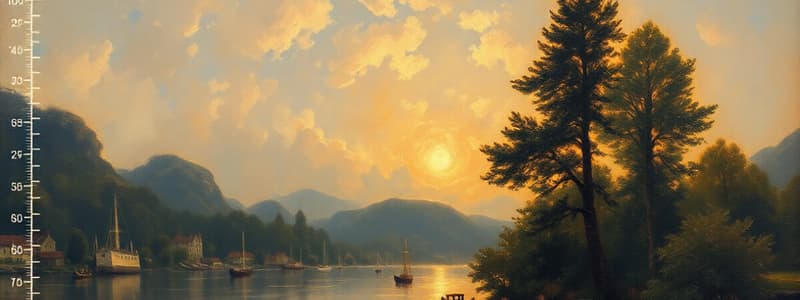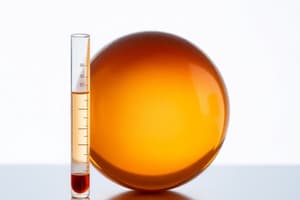Podcast
Questions and Answers
The amount of space that an object occupies is referred to as its ______.
The amount of space that an object occupies is referred to as its ______.
volume
In the metric system, mass is often measured in ______.
In the metric system, mass is often measured in ______.
grams
Temperature can be measured in degrees Celsius or ______.
Temperature can be measured in degrees Celsius or ______.
Fahrenheit
A physical state of matter that maintains a fixed shape is called a ______.
A physical state of matter that maintains a fixed shape is called a ______.
The inherent amount of material in an object is known as its ______.
The inherent amount of material in an object is known as its ______.
The ______ of an object determines how much matter it contains.
The ______ of an object determines how much matter it contains.
The metric unit for measuring small volumes is the ______.
The metric unit for measuring small volumes is the ______.
Water freezes at 0 degrees ______ and boils at 100 degrees ______.
Water freezes at 0 degrees ______ and boils at 100 degrees ______.
The ______ state of matter has a definite shape and volume.
The ______ state of matter has a definite shape and volume.
The ______ scale is another way to measure temperature besides Celsius.
The ______ scale is another way to measure temperature besides Celsius.
Flashcards
Matter
Matter
Anything that has mass and occupies space.
Mass
Mass
The amount of matter in an object, commonly measured in grams.
Grams
Grams
A metric unit of mass equal to one-thousandth of a kilogram.
Celsius
Celsius
Signup and view all the flashcards
Volume
Volume
Signup and view all the flashcards
Temperature
Temperature
Signup and view all the flashcards
Fahrenheit
Fahrenheit
Signup and view all the flashcards
Volume in Milliliters
Volume in Milliliters
Signup and view all the flashcards
Solid
Solid
Signup and view all the flashcards
Study Notes
- Matter is anything that occupies space and has mass.
- Mass is a measure of the amount of matter in an object. It is typically measured in grams (g).
- Grams are a unit of mass in the metric system. One gram is equal to 1/1000 of a kilogram.
- Temperature is a measure of the average kinetic energy of the particles in a substance. It indicates the degree of hotness or coldness.
- Celsius and Fahrenheit are two common temperature scales. Celsius (°C) is a metric unit of temperature, Fahrenheit (°F) is another scale for measuring temperature. The Kelvin scale (K) is also a common temperature scale, but is an absolute temperature scale, where 0 K represents absolute zero.
- Volume is the amount of space occupied by a substance. It's measured in units of cubic meters (m³) or, commonly, milliliters (mL), which is a smaller unit.
- Milliliter (mL) is a unit of volume in the metric system, representing one thousandth of a liter.
- Solid is one of the three fundamental states of matter. Solids have a definite shape and volume. Particles are tightly packed and vibrate in place.
Additional Properties of Matter
- Density: A measure of how much mass is contained in a given volume.
- Density Formula: Density = Mass/Volume
- Units: Density is typically expressed in grams per cubic centimeter (g/cm³) or kilograms per cubic meter (kg/m³).
- Importance: Density plays a role in determining whether an object will float or sink in a liquid or gas. If the object's density is greater than the fluid's density, it sinks. If it's less than the fluid's density, it floats.
- States of Matter: The three fundamental states of matter are solids, liquids, and gases.
- Liquids: Liquids have a definite volume but take the shape of their container. Particles are close together but can move past each other.
- Gases: Gases have neither a definite shape nor a definite volume. Particles are widely dispersed and move randomly in all directions.
- Changes of State: Matter can change from one state to another through processes like melting, freezing, vaporization, condensation, and sublimation.
- Melting: The transition from a solid to a liquid.
- Freezing: The transition from a liquid to a solid.
- Vaporization: The transition from a liquid to a gas. This can happen through evaporation (at the surface) or boiling (throughout the liquid).
- Condensation: The transition from a gas to a liquid.
- Sublimation: The transition from a solid directly to a gas, or vice versa.
- Physical vs. Chemical Properties:
- Physical Properties: Properties that can be observed without changing the substance's chemical composition (e.g. color, density, melting point).
- Chemical Properties: Properties that describe how a substance reacts with other substances (e.g. flammability, reactivity with acids).
Studying That Suits You
Use AI to generate personalized quizzes and flashcards to suit your learning preferences.




